Bristol Parkway railway station
Bristol Parkway railway station, on the South Wales Main Line, is in the Stoke Gifford area in the northern suburbs of the Bristol conurbation. It is 112 miles (180 km) from London Paddington. The station was opened in 1972 by British Rail, and was the first in a new generation of park and ride stations. It is the third-most heavily used station in the West of England, after Bristol Temple Meads and Bath Spa. There are four platforms, and a well-equipped waiting area. The station is managed by Great Western Railway, who provide most of the trains at the station, with CrossCountry providing the rest.
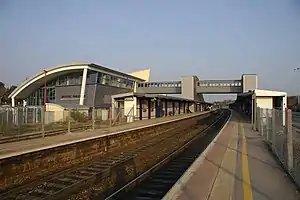 A 2009 view of Bristol Parkway station from the west. | |
| Location | Stoke Gifford, South Gloucestershire England |
| Coordinates | 51.51360°N 2.54270°W |
| Grid reference | ST624795 |
| Managed by | Great Western Railway |
| Platforms | 4 |
| Other information | |
| Station code | BPW |
| Classification | DfT category B |
| History | |
| Original company | Western Region of British Railways |
| Key dates | |
| 1 May 1972 | Station opened |
| 1 July 2001 | Refurbishment completed |
| 9 May 2007 | Third platform opened |
| 13 April 2018 | Fourth platform opened |
| Passengers | |
| 2015/16 | |
| Interchange | |
| 2016/17 | |
| Interchange | |
| 2017/18 | |
| Interchange | |
| 2018/19 | |
| Interchange | |
| 2019/20 | |
| Interchange | |
| Notes | |
Passenger statistics from the Office of Rail and Road | |
Electrification using the 25 kV AC overhead system reached Bristol Parkway in late 2018, and electric trains in the Swindon and London direction commenced passenger service on 30 December 2018. This is part of the planned modernisation of the Great Western Main Line.
Description
Bristol Parkway is located in the unitary authority of South Gloucestershire, in the Stoke Gifford area of the Bristol conurbation. The immediate surrounding area is mostly residential, with farmland to the south east.[1] The main road access is from the west, with the station situated close to the M4, M5 and M32 motorways, the latter being the Bristol "Parkway" from which the station takes its name,[2] as well as the A4174 Avon Ring Road.[1] The station is on the South Wales Main Line from London to Swansea, 111 miles 68 chains (180.01 km) from the eastern terminus at London Paddington.[3][note 1] It is also on the Cross Country Route from Bristol Temple Meads to York. Just to the west of the station is Stoke Gifford Junction, where the Henbury Loop Line to Avonmouth Docks and Cross Country Route to Bristol Temple Meads diverge from the line to South Wales.[4] Stoke Gifford train maintenance depot is located within the junction's confines.[5] To the east is a Network Rail maintenance training centre.[6][7] The next station north along the Cross Country Route is Yate, the next station south is Filton Abbey Wood. The next station east along the South Wales Main Line is Swindon, the next station west is Patchway, however there are only two trains per day calling at both Bristol Parkway and Patchway.[4][8][9][10]
The station is on an east/west alignment, with the main station building and car park to the north of the line.[11] There are six lines through the station, of which the inner four have platforms, the outer two being goods loops. There is a goods yard adjacent to the station to the south.[1][4][12] The station has four platforms, numbered 1 to 4 from south to north. Platforms 1 and 2 share an island to the south of the two central lines, platform 1 is on the south side of the island and serves southbound trains towards Bristol Temple Meads, platform 2 is on the north side of the island and serves westbound trains towards Wales and Bristol Temple Meads. Platforms 3 and 4 share an island to the north of the two central running lines. Platform 3 serves mainly inter-city trains towards London and Birmingham New Street, while platform 4 is usually reserved for local services. An enclosed footbridge provides access to the platforms, approximately a third of the way along platforms 2 and 3 (from west to east), and at the west end of platforms 1 and 4.[11][13] Platforms 2 and 3 are opposite each other, while platforms 1 and 4 are offset from platform 3, starting at the footbridge and extending further to the east. All platforms are 280 metres (310 yd) long. Platforms 1, 3 and 4 are signalled for bidirectional running, while platform 2 is unidirectional.[12] The footbridge can be accessed by both stairs and lifts.[11]
The station building, a sweeping metal construction opened in 2001,[13] contains a booking office, waiting rooms, payphones, cash machines, shops, toilets and a café overlooking the tracks. There are waiting rooms on each platform, as well as vending machines and LED displays giving next train information. Ticket barriers are in use at the station. The pay-and-display car park, run by APCOA, has 1,810 spaces.[11][14][15][16]
Bristol Parkway was the first of a new generation of park and ride railway stations, and a large number of passengers use it for that purpose. Over the decade 2002–2012, the number of passengers starting or ending a journey at Bristol Parkway grew by 1 million passengers per year to 2.25 million, with a further 740,000 passengers changing trains there, giving an annual footfall of just under 3 million passengers and making it the 216th busiest station in the country and the third busiest in the West of England (after Bristol Temple Meads and Bath Spa) as of the 2011/12 financial year.[15][17][18] In the 2006/07 financial year, over 100,000 passengers used Parkway to travel to or from Bristol Temple Meads,[19] and a further 500,000 used it to travel to or from London Paddington.[20]
The line through Bristol Parkway has a linespeed of 60 miles per hour (97 km/h) on platforms 2 and 3 (40 miles per hour (64 km/h) westbound on platform 3), and 25 miles per hour (40 km/h) on platform 4.[12] The loading gauge is W8, and the line handles over 20 million train tonnes per year.[21] The lines through the station were electrified in late 2018 as part of the 21st-century modernisation of the Great Western Main Line.[22]
Services
Rail

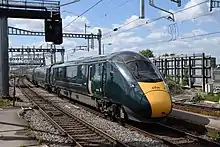
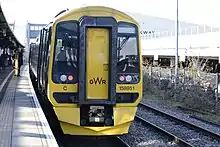
The station is managed by Great Western Railway, who operate most rail services from the station.[11] As of the December 2013 timetable, the basic Great Western Railway weekday service consists of two trains per hour each way between London Paddington and Cardiff Central (with one extended to Swansea), one terminating service to and from Weston-super-Mare, and one service each way between Westbury and Gloucester via Bristol Temple Meads (with one train every two hours extended to Great Malvern and Weymouth).[8][9][23]
CrossCountry also operate trains from Bristol Parkway, the basic weekday service consists of one hourly train each way between Bristol Temple Meads and Manchester Piccadilly, and one hourly train each way between Plymouth, Bristol and Edinburgh Waverley via Leeds and Newcastle. Both these services run via Birmingham New Street.[8][10][24]
Great Western Railway services between London and Wales are formed of High Speed Train (HST) sets or Class 800 bi-mode multiple units,[8] while other GWR services are formed using Class 150, 153, 158 and 166 diesel multiple-unit trains.[25][26][27][28] CrossCountry services are usually formed of Class 220 and 221 Voyager diesel-electric multiple units, with some services between Scotland and the South West employing HST sets.[10]
The standard journey time to London Paddington is 90 minutes, to Cardiff Central 40 minutes, to Birmingham New Street 75 minutes, and to Bristol Temple Meads 12 minutes.[8][10]
| Preceding station | Following station | |||
|---|---|---|---|---|
| Bristol Temple Meads | CrossCountry Bristol – Manchester |
Cheltenham Spa | ||
| CrossCountry South West – North East and Scotland |
||||
| Swindon | Great Western Railway London – Cardiff/Swansea |
Newport | ||
| Yate | Great Western Railway Great Malvern/Gloucester – Westbury/Weymouth |
Filton Abbey Wood | ||
| Terminus | Great Western Railway Bristol Parkway – Weston-super-Mare |
|||
Bus
Bristol Parkway is served by several bus routes linking it with the rest of Bristol and South Gloucestershire. These include
- 3B (The Centre to Aztec West)
- 18 (Cribbs Causeway to Bath via Keynsham and Saltford)[29]
- 19 (Cribbs Causeway to Bath via Bitton and Kelston)
- 73 (Temple Meads to Cribbs Causeway)
- 77 (Thornbury to Broadmead)
- Y6 (Southmead Hospital to Chipping Sodbury via Yate)
- 625 (University of West England to Severn Beach)
These routes are operated by First West of England and Stagecoach West.[30][31]
History
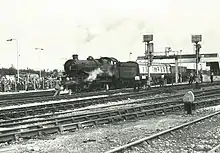
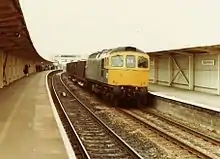
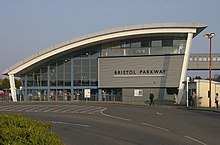
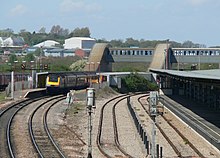
The line through Bristol Parkway was originally opened in 1903 as part of the Great Western Railway's "Badminton Line" from Wootton Bassett to Patchway, a short-cut for trains from London to South Wales, avoiding Bath and Chippenham.[13] The station was built on the site of the Stoke Gifford marshalling yard, which closed on 4 October 1971, having become surplus to requirements with the cessation of wagonload freight trains.[32] The station's development was seen as a response to the potential growth of housing and commercial developments in north Bristol, with proximity to the M4 and M5 motorway interchange at Almondsbury also important.[13] The name "Parkway" came from proximity to the M32 motorway, known as the Bristol Parkway,[2] although the term Parkway has since been applied to park and ride stations throughout the United Kingdom.[4] When the station was built it was outside the developed urban area, but the growth of housing and commercial development in adjoining areas of the North Fringe has brought it within the conurbation, with many large office complexes opened nearby.[1][15][33][34]
The station, owned by British Rail, opened on 1 May 1972.[35] Services were operated by the Western Region until British Rail was split into business-led sectors in the 1980s, after which Parkway was served by the InterCity and Regional Railways divisions. The original structures, built by Stone & Co. of Bristol, were basic – two island platforms connected by an open metal footbridge, with a wood and brick building containing the booking facilities and waiting rooms. Platform 1 (the current platform 3), on the north side of the tracks, was for trains towards London and Birmingham, and platform 2 was for trains towards Wales and Bristol Temple Meads.[13] The platforms were 256 metres (280 yd) long.[36] The station opened with a 600-space car park and a fastest journey to London of 95 minutes, which was subsequently reduced to 75 minutes with the introduction of the new High Speed Trains in 1976.[37][32][38] Platform canopies were added in 1973, along with a cover for the footbridge. Further minor improvements were implemented over the next thirty years, including a new booking office and extensions to the car park.[13]
Following the privatisation of British Rail in 1997, services at Bristol Parkway were franchised to several different train operating companies. South Wales Main Line services were provided by Great Western Trains, which was later rebranded as First Great Western;[39] services from Bristol to Birmingham and the north were operated by Virgin CrossCountry;[40] and local services were franchised to Wales & West,[41] which was in turn succeeded in 2001 by Wessex Trains.[42] The Wessex franchise was amalgamated with the Great Western franchise into the Greater Western franchise from 2006, and awarded to First Great Western, which became known as Great Western Railway in 2016.[43][44][45][46] Virgin CrossCountry services were taken over by Arriva CrossCountry in 2007.[47]
In the August 1998, the Royal Mail began construction of the a mail terminal to the east of the station, taking over some of the station car park to provide a platform and warehouse for postal trains.[48] The 12,000 square feet (1,100 m2) building opened on 15 May 2000 replacing a similar facility at Bristol Temple Meads, with the Royal Mail stating it would save 250,000 miles (400,000 km) of lorry journeys per year on local roads.[13][49][50][51] However, the depot closed only four years later in 2004, when the Royal Mail ceased to use the rail network.[52] Royal Mail offered the terminal for use by freight companies, but as there were no takers it was demolished in October 2007.[49][53] In 2008, Network Rail opened a maintenance training centre on the site in a £2.5 million project which saw the construction of a mezzanine floor, a welding workshop and a 4,000 square feet (370 m2) extension.[6][7]
In 2000, work began on a complete redevelopment of the station building with a new enclosed footbridge. It opened on 1 July 2001, and featured lifts and generally enhanced facilities. Local roads were enhanced to help speed passengers' journeys to and from the station, and a new multi-storey car park was built to replace the spaces lost to the Royal Mail facility.[13][54] A dedicated bus interchange was opened in 2003.[15] In 2006, construction started on a new 278 metres (304 yd) long platform face on the north side of platform 1, to ease congestion for trains toward Birmingham and London. The new platform, platform 4, was opened on 9 May 2007 by rail minister Tom Harris MP. As part of the reconstruction, the waiting room at the east end of platform 1 was demolished, and replaced with an extended waiting area and customer help desk. Platform 1 was subsequently redesignated platform 3. The work cost £3,000,000, and was funded by Network Rail, with First Great Western contributing £100,000 towards the new waiting room and help desk.[55]
Despite the large car park, the increase in passenger numbers at Parkway in recent years has led to problems with on-street parking, leading to the commissioning of a new 200-space car park 500 metres (550 yd) east of the station.[15][56] It opened in Spring 2011, but was used by only 139 motorists in its first three months, and as of August 2012 was averaging only 10 motorists per day. It was expected that traffic would increase when a new bus link was opened to transfer drivers from the car park to the station.[57] A new multi-storey car park on the station site with 710 spaces was opened on 5 September 2014 by Baroness Kramer, Minister of State for Transport. Construction of the car park, which began in mid-2013, caused a short-term lack of spaces for commuters.[58] The car park cost £13 million and was funded jointly by Network Rail and the Department for Transport under the Station Commercial Projects Fund.[14][16] Improved cycle facilities, including a bike hire scheme, were provided in the late 2000s.[15]
The station was closed for two weeks in September 2017 to allow for upgrade work as part of the electrification and upgrade work for the Great Western route. Works included resignalling, installation of overhead electrification gantries, and the start of construction of a new fourth platform on the south side of platform 2.[59][60] The new platform 1 took over an existing goods loop, allowing trains towards Bristol and towards Wales to be accommodated at the same time, thus easing a bottleneck. It was opened on 13 April 2018 by Chris Grayling MP, Secretary of State for Transport. The other platforms were lengthened to 280 metres (310 yd) at the same time.[12][36][61][62] The station closed for three weeks in Autumn 2018 for further electrification works, including the installation and testing of overhead wires.[63][64]
Future
First Great Western declined a contractual option to continue the Greater Western passenger franchise beyond 2013, citing a desire for a longer-term contract due to the impending upgrade to the Great Western Main Line.[45] The franchise was put out to tender,[65][66][67] but the process was halted and later scrapped due to the fallout from the collapse of the InterCity West Coast franchise competition.[68] A two-year franchise extension until September 2015 was agreed in October 2013,[69][70] and subsequently extended until March 2019.[71][72][73] The CrossCountry franchise is due to expire in October 2019.[74] However it was announced in September 2020 that the emergency timetables introduced to meet Covid-19 requirements would continue for a further 18 months and the letting of new franchises scrapped.
The South Wales Main Line from London to Cardiff is currently undergoing electrification works.[22][75] However, the lines to Weston-super-Mare and Birmingham will not be electrified, so local and CrossCountry services will still be provided by diesel trains, with "Sprinter" units on local services to be replaced by Class 165 and 166 "Turbo" units.[76][77] The group Friends of Suburban Bristol Railways supports the electrification continuing to Weston,[78][79] as does MP for Weston-super-Mare John Penrose.[80][81]
Bristol Parkway is on the Weston-super-Mare/Yate corridor, one of the main axes of the Greater Bristol Metro, a rail transport plan which aims to enhance transport capacity in the Bristol area.[82][83] The scheme could see the reopening of the Henbury Loop Line to passengers, with the possibility of services from Bristol Temple Meads to Bristol Parkway via Clifton Down and Henbury.[84]
Metrobus route M3 is scheduled to terminate at the station, however access roads will need to be redesigned as they are currently too narrow for the buses to allow it to be extended from Emersons Green.[85][86] Work to rectify this is expected to be completed in 2019, however there is no set date for when services will start.[87]
See also
- List of all UK railway stations
- Rail services in Bristol
Notes
- Railways in the United Kingdom are, for historical reasons, measured in miles and chains. There are 80 chains to the mile.
References
- OS Landranger Map 172 – Bristol & Bath. Southampton: Ordnance Survey. 2008. ISBN 978-0-319-22914-9.
- "M32 'like dagger thrust' into city". BBC News. BBC. 9 December 2008. Retrieved 22 September 2013.
- Deaves, Phil. "Railway station data, location B". Retrieved 22 September 2013.
- Baker, S.K. (2010). Rail Atlas of Great Britain and Ireland (12th ed.). Ian Allan. ISBN 978-0-86093-632-9.
- "Bristol rail depot scheme given planning approval". BBC News. BBC. 2 February 2012. Retrieved 25 April 2018.
- "Bristol Parkway Maintenance Centre". Curtins. Archived from the original on 28 September 2013. Retrieved 24 September 2013.
- "The Bristol training centre putting engineers on track". This is Bristol. Northcliffe Media. 8 August 2008. Archived from the original on 29 September 2013. Retrieved 29 September 2013.
- "Central 1: Guide to train times 8 December 2013 to 17 May 2014 – London to Bristol, Cheltenham Spa and South Wales". First Great Western. November 2013. Archived from the original on 3 December 2013. Retrieved 28 November 2013.
- "Central 4: Guide to train times 8 December 2013 to 17 May 2014 – Cardiff and Bristol to Weston-super-Mare and Taunton". First Great Western. November 2013. Archived from the original on 3 December 2013. Retrieved 28 November 2013.
- "Manchester to the South West & South Coast" (PDF). CrossCountry. May 2013. Retrieved 29 September 2013.
- "Bristol Parkway (BPW)". National Rail. Retrieved 22 September 2013.
- "Western Route Sectional Appendix". Network Rail. 3 March 2018. p. 248. Retrieved 25 April 2018.
- Oakley, Mike (2003). Gloucestershire Railway Stations. Wimbourne, Dorset: The Dovecote Press. pp. 29–30. ISBN 1-904349-24-2.
- Johnston, Howard (7–20 August 2013). "Regional News". RAIL. Peterborough: Bauer Media (728): 24–25.
Bristol Parkway: Construction has started on a new £13 million, 710-space multi-story car park.
- "Station Travel Plans: National Pilot Programme – Bristol Parkway". Association of Train Operating Companies. Archived from the original on 16 October 2013. Retrieved 29 September 2013.
- "Bristol Parkway Extension Launched". Insider Media Ltd. 9 September 2014. Retrieved 9 September 2014.
- "Station Usage Estimates 2011/12". Office of Rail and Road. Retrieved 23 September 2013.
- "Station Usage Estimates 2002/03". Office of Rail and Road. Archived from the original on 28 September 2007. Retrieved 23 September 2013.
- "Great Western Route Utilisation Strategy – Key Flows to/from Bristol" (PDF). Network Rail. 2006–2007. Archived from the original (PDF) on 1 October 2012. Retrieved 23 September 2013.
- "Great Western Route Utilisation Strategy – Key Flows to/from London Paddington" (PDF). Network Rail. 2006–2007. Archived from the original (PDF) on 27 September 2013. Retrieved 23 September 2013.
- "Route 13: Great Western Main Line" (PDF). Network Rail. 2006. Archived from the original (PDF) on 14 October 2013. Retrieved 23 September 2013.
- "Modernising the Great Western" (PDF). Network Rail. Archived from the original (PDF) on 13 April 2013. Retrieved 9 June 2012.
- "Central 5: Guide to train times 8 December 2013 to 17 May 2014 – Bristol to Gloucester, Cheltenham Spa and the Malverns". First Great Western. November 2013. Archived from the original on 3 December 2013. Retrieved 28 November 2013.
- "Scotland, the North East to the South West and South Coast" (PDF). CrossCountry. May 2013. Retrieved 29 September 2013.
- Miles, Tony (December 2010). "LOROL Class 150s all with FGW". Modern Railways. London. p. 90.
- Salveson, Paul (June 2012). Abell, Paul (ed.). "Severn Beach: Not your typical branch line!". Today's Railways UK. Sheffield: Platform 5 (126): 42–47.
- "Taunton-bound passengers from Bristol to benefit from trains with more seats and better WiFi". County Gazette. Newsquest. 25 October 2017. Retrieved 27 October 2017.
- "Does Great Western Railway's Class 800 IET pass the test?". Rail. 841. Bauer Media. 25 January 2018. Retrieved 25 April 2018.
- "Changes to bus services". South Gloucestershire Council. Retrieved 23 February 2020.
- "Bristol Parkway Station – Onward Travel Information" (PDF). National Rail. 2012–2013. Retrieved 23 September 2013.
- "Bristol Bus Network Map" (PDF). Travel West. January 2018. Retrieved 25 April 2018.
- Robertson, Kevin; Abbot, David (1988). GWR: The Badminton Line – Portrait of a Railway. Alan Sutton Publishing. pp. 202–206. ISBN 0-86299-459-4.
- OS 1" 7th Series No. 156 – Bristol & Stroud. Southampton: Ordnance Survey. 1946.
- Kerton, Adrian (ed.). "History of Stoke Gifford – Aerial Photographs of the Parish". Archived from the original on 4 October 2013. Retrieved 4 October 2013.
- Butt, R. V. J. (1995). The Directory of Railway Stations: details every public and private passenger station, halt, platform and stopping place, past and present (1st ed.). Sparkford: Patrick Stephens Ltd. p. 44. ISBN 978-1-85260-508-7. OCLC 60251199.
- "Network Capability – Baseline Declaration: (1) Track and Route mileage: (2) Line-speeds: Western Route" (PDF). Network Rail. 1 April 2009. p. 220. Archived from the original (PDF) on 14 October 2013. Retrieved 11 October 2013.
- Forsythe, Robert (13 December 2000). "Is collecting railway ephemera an archaeological task?". Institute of Railway Studies Research Workshop on 'railway ephemera'. University of York. Retrieved 4 October 2013.
- Maggs, Colin G (2008) [First published 1981]. Rail Centres: Bristol (#21) (3rd ed.). Nottingham: Booklaw Publications. pp. 26–27. ISBN 978-1-901945-30-0.
- "Rail bosses cash in on privatised gravy train". The Independent. 7 March 1998. Retrieved 29 September 2013.
- "New Cross Country Franchise Consultation Document" (PDF). Department for Transport. June 2006. Archived from the original (PDF) on 2 September 2009. Retrieved 29 September 2013.
- Deaves, Phil (5 May 2015). "UK railway franchises". Retrieved 6 May 2015.
- "Wales and West". Wales & West. Archived from the original on 14 March 2012. Retrieved 9 June 2012.
- "Wessex Trains". The Iron Road: Railway Photography by Scott Borthwick. Retrieved 29 September 2013.
- "FirstGroup wins rail franchises". BBC News. BBC. 13 December 2005. Retrieved 27 April 2012.
- "First Great Western bids for longer rail franchise deal". BBC News. BBC. 11 May 2011. Retrieved 27 April 2012.
- "The Great Western Railway is back in business". Railnews. 21 September 2015. Retrieved 21 September 2015.
- "New rail franchise to increase capacity between major cities" (Press release). Department for Transport. 10 July 2007. Archived from the original on 12 August 2007. Retrieved 29 September 2013.
- "Temple Meads loses out as work starts on new Parkway mail centre". Rail. 334. Peterborough: Bauer Media. 1 July 1998. p. 16.
- "Ex-mail Depot Set For New Use". Bristol Evening Post. Northcliffe Media. 3 July 2006.
- "Bristol Mail hub opens" The Railway Magazine issue 1191 July 2000 page 97
- "Royal Mail terminal opens at Bristol Parkway". Rail. 384. Peterborough: Bauer Media. 31 May 2000. p. 7.
- Butcher, Louise (13 April 2010). "Railways: Royal Mail services, 2003–" (PDF). House of Commons Library. Retrieved 29 September 2013.
- "Not even four year's use... demolished". The Railway Magazine. 1281. January 2008. p. 9.
- Johnston, Howard (August 2001). "Regional News". Rail. 416. Peterborough: Bauer Media. p. 22.
- "New platform for Bristol Parkway" (Press release). Network Rail. 9 May 2007. Archived from the original on 29 September 2013. Retrieved 29 September 2013.
- "New Bristol park and ride to keep cars off road". This is Bristol. Northcliffe Media. 6 July 2009. Archived from the original on 11 June 2015. Retrieved 29 September 2013.
- Koch, Emily (28 August 2012). "Spaces at £1.2m car park at Stoke Gifford still not being used". This is Bristol. Northcliffe Media. Archived from the original on 30 August 2012. Retrieved 29 September 2013.
- "Anger over Bristol Parkway railway parking shortage". BBC News. BBC. 20 September 2013. Retrieved 21 September 2013.
- "Passengers warned to expect major disruption as Bristol Parkway station shuts for two weeks". ITV News. 1 September 2017. Retrieved 22 September 2017.
- "Great Western modernisation moves forward as NR completes key upgrade". Rail Technology Magazine. Cognitive Publishing. 18 September 2017. Retrieved 22 September 2017.
- "Bristol Parkway's new platform officially opens". BBC News. BBC. 13 April 2018. Retrieved 25 April 2018.
- "New platform at Bristol Parkway opened to increase train frequency". Railway Technology. Kable Intelligence. 17 April 2018. Retrieved 25 April 2018.
- "Major rail disruption as Bristol Parkway closes for three weeks". ITV News. 14 September 2018. Retrieved 16 September 2018.
- "South Gloucestershire". Network Rail. 6 September 2018. Retrieved 16 September 2018.
- Haigh, Philip (18 April 2012). "First leads a field of seven bidding for rail franchises". Rail. Peterborough: Bauer Media (694): 8–9.
- "Great Western franchise to be extended". Railnews. 19 July 2012. Retrieved 19 July 2012.
- "New Great Western franchise to deliver new express trains" (Press release). Department for Transport. 27 July 2012. Retrieved 29 July 2012.
- "Great Western London to south Wales rail contest scrapped". BBC News. BBBC. 31 January 2013. Retrieved 31 January 2013.
- "First celebrates last-minute Great Western deal". Railnews. 3 October 2013. Retrieved 4 October 2013.
- "First Great Western retains Wales and west rail franchise". BBC News. BBBC. 3 October 2013. Retrieved 4 October 2013.
- "First Great Western offered new franchise deal". BBC News. BBC. 10 October 2014. Retrieved 10 October 2014.
- "FirstGroup wins Great Western contract extension". The Guardian. Guardian Media Group. 10 October 2014. Retrieved 10 October 2014.
- "Updated franchise schedule signals GW extension". Railnews. 10 October 2014. Retrieved 10 October 2014.
- McLoughlin, Patrick (26 March 2013). "Written statement to Parliament – Rail franchising" (Press release). Department for Transport. Retrieved 5 October 2013.
- "Bristol to London line to be electrified". This is Bristol. Northcliffe Media. 23 July 2009. Retrieved 5 April 2012.
- "Weston-super-Mare to London rail re-franchise concerns". BBC News. BBC. 10 August 2012. Retrieved 13 August 2012.
- Clinnick, Richard (15 April 2015). "How the West will win with new trains". Rail. Peterborough: Bauer Media (772): 58–59. Retrieved 12 October 2015.
- "Benefits of Bristol to London high-speed rail link 'must go beyond just mainline'". This is Bristol. Northcliffe Media. 3 March 2011. Retrieved 5 April 2012.
- "FoSBR Newsletter" (PDF). Friends of Suburban Bristol Railways. Autumn 2011. Archived from the original (PDF) on 4 February 2012. Retrieved 9 April 2012.
- Penrose, John (17 July 2009). "Weston's rail commuter services could be cut, warns town's MP" (Press release). Archived from the original on 3 January 2013. Retrieved 5 April 2012.
- "MP takes drive for better rail services to top". This is Bristol. 29 October 2011. Archived from the original on 16 October 2013. Retrieved 5 April 2012.
- White, James (13 March 2009). "Item 04: Greater Bristol Metro" (PDF). West of England Partnership. Retrieved 28 December 2011.
- "Campaign for trains from Bristol Temple Meads every half-hour". This is Bristol. Northcliffe Media. 17 January 2012. Archived from the original on 20 January 2012. Retrieved 19 January 2012.
- Ribbeck, Michael (6 July 2012). "£100 million Bristol Metro train network by 2016". The Post, Bristol. Northcliffe Media. Archived from the original on 8 July 2012. Retrieved 6 July 2012.
- "MetroBus will have to widen Bristol Parkway roads to access station". Bristol Post. Local World. 1 December 2017. Retrieved 13 December 2017.
- "Bristol Parkway has disappeared off the Metrobus map because buses can't get to the station". Bristol Post. Local World. 24 April 2018. Retrieved 5 May 2018.
- Ashcroft, Esme (7 June 2018). "When Metrobus services could start running at Bristol Parkway station". Bristol Live. Local World. Retrieved 21 June 2018.
External links
| Wikimedia Commons has media related to Bristol Parkway railway station. |